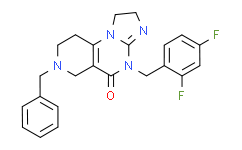| Cas No.: | 1638178-87-6 |
| Chemical Name: | CID 135297777 |
| Synonyms: | ONC206;CID 135297777;7-Benzyl-4-(2,4-difluorobenzyl)-1,2,6,7,8,9-hexahydroimidazo[1,2-a]pyrido[3,4-e]pyrimidin-5(4H)-one;OW6LM47PNK |
| SMILES: | O=C1C2CN(CCC=2N2C(=NCC2)N1CC1C(F)=CC(F)=CC=1)CC1C=CC=CC=1 |
| Formula: | C23H22F2N4O |
| M.Wt: | 408.443791866302 |
| Purity: | >98% |
| Sotrage: | 2 years -20°C Powder, 2 weeks 4°C in DMSO, 6 months -80°C in DMSO |
| Description: | ONC206 is an analogue of TRAIL inducer ONC201[1]. ONC206 is a selective antagonist of the D2-like dopamine receptors (DRD2/3/4) at nanomolar concentrations. ONC206 has broad-spectrum anti-tumor activity[2]. |
| Target: | DRD2/3/4[2] |
| In Vivo: | ONC206 (100 mg/kg;p.o.; every 10 days) causes significant tumor growth inhibition[2]. |
| In Vitro: | ONC206 selectively antagonizes the D2-like (DRD2/3/4), but not the D1-like (DRD 1/5), subfamily of dopamine receptors[2]. ONC206 significantly inhibits tumor cell migration and invasion in vitro[1]. ONC206 (0.05 μM; Over 48 hours) inhibits migration of ONC201- and TRAIL-resistant HCT116 Bax−/− cells without inducing cell death or inhibiting cell proliferation[1]. ONC206 engages the ISR and TRAIL pathway leading to tumor growth arrest and cell death[1]. ONC206 does not induce cell cycle arrest in a colorectal cell line with acquired ONC201-resistance[1]. Cell Proliferation Assay[1] Cell Line: HCT116 cells Concentration: 0.05 μM Incubation Time: Over 48 hours Result: Inhibited migration of ONC201- and TRAIL-resistant HCT116 Bax−/− cells. |
| References: | [1]. Wagner J, et al. Preclinical evaluation of the imipridone family, analogs of clinical stage anti-cancer small molecule ONC201, reveals potent anti-cancer effects of ONC212. Cell Cycle. 2017 Oct 2;16(19):1790-1799. [2]. Varun Vijay Prabhu, et al. Potent anti-cancer activity of the imipridone ONC206: A selective dopamine D2-like receptor antagonist. AACR Annual Meeting 2017, April 1-5, 2017; Washington, DC. |

 To enhance service speed and avoid tariff delays, we've opened a US warehouse. All US orders ship directly from our US facility.
To enhance service speed and avoid tariff delays, we've opened a US warehouse. All US orders ship directly from our US facility.




















